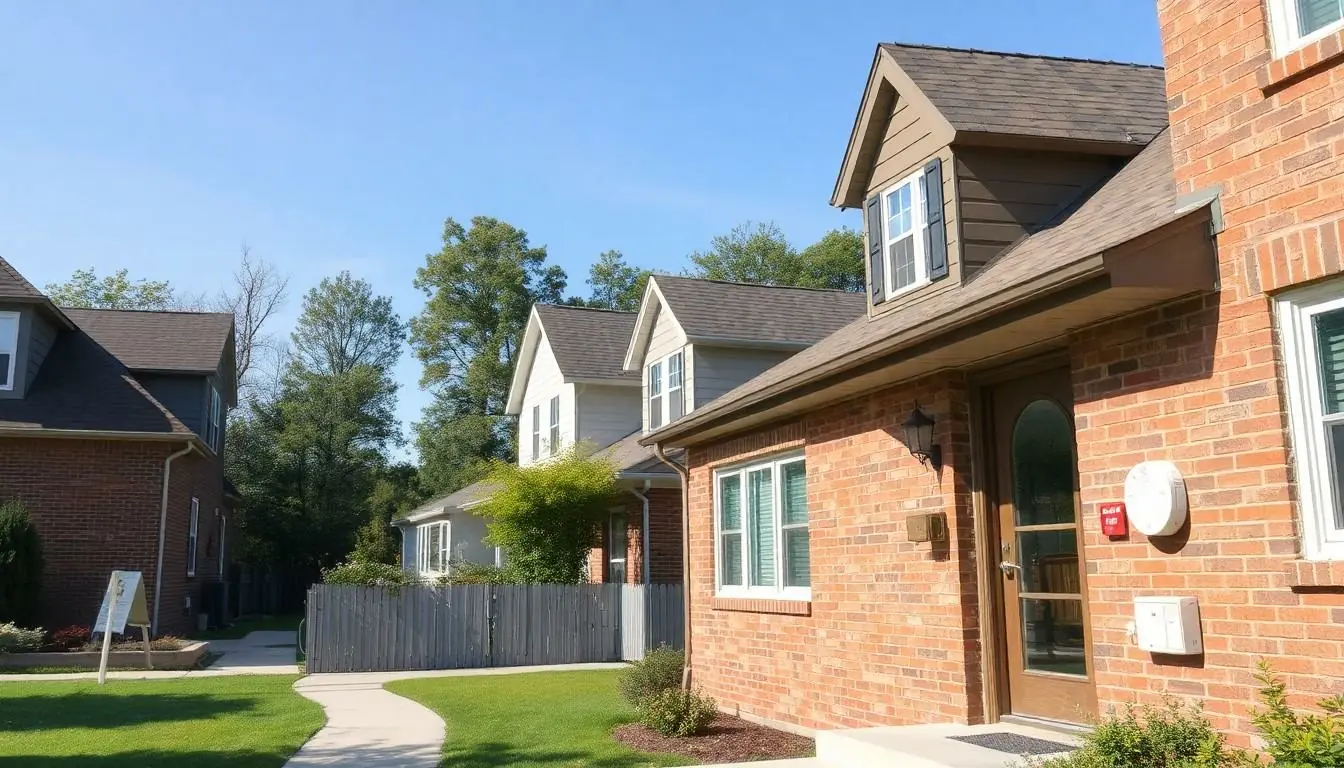Homeowners insurance can feel like that pesky neighbor who always borrows your lawnmower and never returns it—necessary but annoying. With premiums rising faster than a squirrel on a power line, finding ways to save on insurance is more important than ever. Fortunately, there are clever strategies that can help homeowners keep their hard-earned cash in their pockets instead of the insurance company’s.
Imagine slashing your premiums while still enjoying peace of mind. It’s not just a pipe dream; it’s entirely possible with a few smart moves. From bundling policies to increasing deductibles, homeowners can navigate the insurance maze with confidence. So grab a cup of coffee, kick back, and discover how to outsmart your insurance costs without sacrificing coverage.
Table of Contents
ToggleUnderstanding Homeowners Insurance
Homeowners insurance protects against damages to a home and provides liability coverage. It covers various disasters like fire, theft, and natural disasters, ensuring financial safety in unpredictable situations. Policies include several components, making it crucial to understand each aspect.
Property coverage encompasses damage to the actual home structure and personal belongings. Liability coverage protects homeowners from legal claims or lawsuits due to injuries or property damage to others. Additional living expenses coverage helps with costs associated with temporary relocation if the home becomes uninhabitable.
Many factors affect premiums, including location, home age, and claims history. Higher-risk areas result in increased costs, while newer homes often attract lower premiums due to improved safety features. Maintaining a clean claims history proves beneficial; frequent claims can drive up rates significantly.
Deductibles influence the premium amount. A higher deductible typically lowers monthly payments, but can lead to higher out-of-pocket costs during claims. Policyholders must assess their financial situation to determine suitable deductible levels.
Shopping around plays a significant role in finding the best rates. Comparing quotes from multiple insurers provides insight into available options. Additionally, consulting with an insurance agent familiar with local market conditions ensures informed decision-making.
Discounts often exist for bundling homeowners insurance with auto insurance or for implementing security features like alarms and smoke detectors. Homeowners should inquire about available discounts when seeking coverage. Overall, understanding homeowners insurance allows for identifying opportunities for savings while maintaining necessary coverage.
Factors Affecting Homeowners Insurance Costs

Homeowners insurance costs can fluctuate based on several critical factors. Understanding these elements helps homeowners make informed decisions that can lead to significant savings.
Location
Location plays a crucial role in determining insurance premiums. Higher rates often arise in areas susceptible to natural disasters, such as hurricanes or floods. Proximity to fire departments and schools can also impact costs, with neighborhoods close to emergency services typically enjoying lower premiums. Urban areas usually present more risks than suburban or rural settings, leading to increased rates. Insurers evaluate crime rates alongside location; neighborhoods with a history of theft or vandalism face higher charges.
Home Characteristics
Home characteristics significantly influence insurance premiums. The home’s age, structure type, and materials used for construction all matter. Older homes may lack modern safety features, raising their risk assessment. Insurance companies often view brick homes as safer than wood-framed ones, affecting costs. Square footage can also impact premiums; larger homes usually incur higher rates due to increased replacement costs. Additionally, the presence of safety features, like smoke detectors and security systems, can lower premiums.
Coverage Options
Coverage options dictate how much homeowners pay for insurance. Higher coverage limits typically lead to increased premiums, as they provide a broader safety net. Homeowners can select additional endorsements for specialized coverage, amounting to an increase in costs. Opting for higher deductibles often results in reduced monthly premiums, allowing homeowners to balance upfront costs against long-term savings. Personal property coverage and liability limits also require careful consideration, as these elements play significant roles in overall expenses.
Tips on How to Save on Homeowners Insurance
Homeowners can explore several strategies to save on homeowners insurance without sacrificing essential coverage.
Shop Around for Quotes
Comparing insurance quotes from multiple providers is essential. Each company uses unique criteria to determine premiums, so one policy may offer significant savings over another. Homeowners can utilize online comparison tools for quick evaluations. Requesting at least three different quotes allows for a more comprehensive understanding of available rates. Focusing on the same coverage limits helps maintain consistency in comparisons.
Bundle Policies
Combining homeowners insurance with auto or life insurance often leads to substantial discounts. Many insurance companies provide incentives to clients who choose to bundle policies, recognizing the increased loyalty. Bundling policies streamlines management and often results in lower overall costs. Homeowners should verify the specific terms and conditions for bundled savings offered by each insurer. This approach maintains essential coverage while maximizing savings opportunities.
Increase Deductibles
A higher deductible can lower monthly premiums considerably. Homeowners who can afford to pay more upfront in case of a claim may find significant savings. Adjusting deductibles brings potential for improved cash flow over time while maintaining coverage levels. Assessing personal financial situations can steer decisions in this area. Consideration of future unforeseen expenses weighs into the decision-making process.
Maintain a Good Credit Score
Insurance companies often consider credit scores when setting premiums. Better credit scores typically lead to lower insurance rates, reflecting responsible financial behavior. Homeowners should monitor their credit reports regularly, ensuring accuracy and correcting any errors. Maintaining timely payments and reducing debt contributes directly to improved credit scores. This proactive approach can result in better overall insurance rates.
Take Advantage of Discounts
Homeowners can identify various discounts that may apply to their policies. Many carriers provide discounts for advanced security systems, newer homes, or being claim-free for several years. Asking insurers directly about available discounts can uncover savings opportunities. Some companies also offer incentives for completing safety courses or maintaining affiliations with specific organizations. Thorough exploration of all potential discounts maximizes savings potential.
Homeowners can take proactive steps to save on insurance premiums without compromising their coverage. By exploring options like bundling policies and increasing deductibles, they can significantly reduce their monthly costs. Understanding the factors that influence premiums empowers homeowners to make informed decisions that lead to better savings.
Additionally, shopping around for quotes and leveraging available discounts can further enhance their savings strategy. With the right approach, homeowners can navigate the complexities of insurance and keep more money in their pockets while ensuring their homes are well protected. Embracing these strategies not only eases the financial burden but also brings peace of mind in safeguarding their valuable assets.







